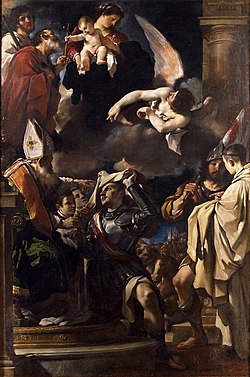St. William of Gellone
| Saint William of Gellone | |
|---|---|

William of Gellone, Guillaume d'Orange, William of Aquitaine by Guercino
|
|
| Born | c. 755 somewhere in Northern France |
| Died | 28 May 812 or 28 May 814 Gellone, near Lodève? |
| Venerated in | Roman Catholic Church, Eastern Orthodox Church |
| Canonized | 1066 by Pope Alexander II |
| Major shrine | Monastery of Saint-Guilhem-le-Désert in Gellone, France |
| Feast | May 28 |
Saint William of Gellone, also known as William of Aquitaine, (c. 755 – 28 May, 812 or 814 [uncertain]) was the second Count of Toulouse from 790 until his replacement in 811. His Occitan name is Guilhem, and he is known in French as Guillaume d'Orange, Guillaume Fierabrace, and the Marquis au court nez. William was canonized a saint in 1066 by Pope Alexander II.
He is the hero of the Chanson de Guillaume, an early chanson de geste, and of several later sequels, which were categorized by thirteenth-century poets as the geste of Garin de Monglane. Another early product of oral traditions about William is a Latin Vita ("Biography"), written before the 11th century, according to Jean Mabillon, or during the 11th century according to the Bollandist Godfrey Henschen.
William was born in northern France in the mid-8th century. He was a cousin of Charlemagne (his mother Aldana was daughter of Charles Martel) and the son of Thierry IV, Count of Autun. As a kinsman and trusted comes, he spent his youth in the court of Charlemagne. In 788, Chorso, Count of Toulouse, was captured by the Basque Adalric, and made to swear an oath of allegiance to the Duke of Gascony, Lupus II. Upon his release Charlemagne replaced him with his Frankish cousin William (790). William in turn successfully subdued the Gascons.
...
Wikipedia
